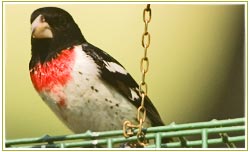About The Rose-breasted Grosbeak
 The Rose-breasted Grosbeak is 8 inches long and has a thick and heavy pinkish-white bill. The male Rose-breasted Grosbeaks are black and white with a very noticeable and obvious rose-red patch on its breast and under wings. The female is white above and below with predominantly brown streaks; conspicuous white eyebrows, and yellow wing linings.
The Rose-breasted Grosbeak is 8 inches long and has a thick and heavy pinkish-white bill. The male Rose-breasted Grosbeaks are black and white with a very noticeable and obvious rose-red patch on its breast and under wings. The female is white above and below with predominantly brown streaks; conspicuous white eyebrows, and yellow wing linings.
The Rose-breasted Grosbeak Nesting Preferences
Rose-breasted Grosbeaks like to build their nests in moist woodlands that are side-by-side with open fields that have tall shrubs.
During the breeding season, the male Rose-breasted Grosbeaks arrive first then begin singing to draw attention to themselves and to protect their territory. Once the females arrive, the male birds perform a mating ritual and soon pairs are formed.
The females then proceed to build a nest for themselves and their brood. The nest is a delicately built saucer of twigs, stems, and grass located 5 to 50 feet above ground in a shrub or tree.
The female then lays 3 to 5, pale blue or green with brown spotted eggs. Together with the male Rose-breasted Grosbeak, the female incubates these eggs for about 13 days. After the eggs are hatched, the young birds slowly gain strength and are asked to leave 9 to 12 days after hatching.
Building a Birdhouse For The Rose-breasted Grosbeak
 There are no specific birdhouses that have been built for the Rose-breasted Grosbeak. However, birdhouses built for bluebirds may also be used for the Rose-breasted Grosbeaks. Just make sure to situate the birdhouses at 4 to 6 feet above the ground and 50 to 100 yards apart. Make the houses face south or southeast, if possible. Choose locations where trees, shrubs, utility wires or fences are within 25 to 100 feet of the houses. These structures will serve as perches for the Grosbeaks when feeding. These perches can also help young birds during their first flights.
There are no specific birdhouses that have been built for the Rose-breasted Grosbeak. However, birdhouses built for bluebirds may also be used for the Rose-breasted Grosbeaks. Just make sure to situate the birdhouses at 4 to 6 feet above the ground and 50 to 100 yards apart. Make the houses face south or southeast, if possible. Choose locations where trees, shrubs, utility wires or fences are within 25 to 100 feet of the houses. These structures will serve as perches for the Grosbeaks when feeding. These perches can also help young birds during their first flights.
The Rose-breasted Grosbeak Mating Habits
Rose-breasted Grosbeaks are monogamous although the pair-bonds last only for one season. The male arrives at the breeding site first to look for an appropriate nesting site then the female follows and, after a brief courtship characterized mostly by singing to one another, the female then builds a nest, lays the eggs, incubates them together with her male partner, then takes care of the fledglings till theyre ready to leave the nest.
The female Rose-breasted Grosbeaks raise 1 to 2 broods per season.
The Rose-breasted Grosbeak Feeding Preferences
Rose-breasted Grosbeaks have a large, conical bill that they use to eat a variety of seeds, fruit and insects. Foraging for food in the wooded environment they dwell in, these birds typical diet includes seeds of elms, the blossoms of hickory or beech trees and the buds of white ash. Insects of the forest such as gypsy moths and tent caterpillars are table fare for grosbeaks.
Rose-breasted Grosbeaks also relish sunflower seeds and this takes them to the hopper feeders that are stocked with striped or black-oil sunflower seeds.
Interesting Rose-breasted Grosbeak Facts
Unlike most birds that keep still in their nests during incubation to avoid attention and prevent attacks by predators, the male Rose-breasted grosbeaks sing while incubating their eggs.